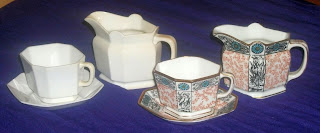I have added several pieces to my collection over the last few weeks, and strangely enough a couple of them presented an opportunity to discuss the manufacturing processes that go into making a 'before and after'.
My first example is a traditional looking jug by the Livesley Powell & Co partnership from the 1860s. The jug on the left shows what the jug looks like with two processes complete: a puce botanical transfer print and green enamel highlighting the raised moulding of oak leaves. When I first saw this jug for sale, I naturally assumed that was the final design, but on inspection of the jug on the right, one can see that another two processes have been added on top to further enhance the design: coloured enamels filling in the transfer print and a copper lustre applied over the green colour of the oak leaves. Now, I suppose one could argue that both are indeed two similar, but in themselves, complete renderings of the designs. It may be that LP&Co did release the jug on the left as a finished product. But my hunch is that it left the factory before all the intended processes were complete, perhaps with a light-fingered decorator.


This next example shows the plain white wares of an aesthetic teaset, and then on the right, complete with its transfer printed design. Curiously and perhaps understandly, the seller of the plain set thought they were from the Art Deco period - probably due to their angular form. It was obvious to me, however, because I already had the transfer printed set, that this was made around 30 years prior to the Art Deco movement's beginnings. What is apparent from the white set is that they have been well used, for despite having no chips or cracks, most of the pieces are tea stained. The transfer set is as clean as a whistle and would undoubtedly have sat in someone's cabinet for much of its life, unused, but much admired (as it is today in my collection).

 This next example shows the plain white wares of an aesthetic teaset, and then on the right, complete with its transfer printed design. Curiously and perhaps understandly, the seller of the plain set thought they were from the Art Deco period - probably due to their angular form. It was obvious to me, however, because I already had the transfer printed set, that this was made around 30 years prior to the Art Deco movement's beginnings. What is apparent from the white set is that they have been well used, for despite having no chips or cracks, most of the pieces are tea stained. The transfer set is as clean as a whistle and would undoubtedly have sat in someone's cabinet for much of its life, unused, but much admired (as it is today in my collection).
This next example shows the plain white wares of an aesthetic teaset, and then on the right, complete with its transfer printed design. Curiously and perhaps understandly, the seller of the plain set thought they were from the Art Deco period - probably due to their angular form. It was obvious to me, however, because I already had the transfer printed set, that this was made around 30 years prior to the Art Deco movement's beginnings. What is apparent from the white set is that they have been well used, for despite having no chips or cracks, most of the pieces are tea stained. The transfer set is as clean as a whistle and would undoubtedly have sat in someone's cabinet for much of its life, unused, but much admired (as it is today in my collection).



2 comments:
Hiya, just found your blog as i was searching for info in regards to Powell Bishop and Stonier Oriental Ivory collection we believe the pattern is Hong Kong and originates from 1880. We have over 30 pieces ranging from plates, bowls to platters and serving bowls. I have tried to contact a few people but with no luck, but you seem to know your stuff. Is it valuable? Worth selling? Would you be interested? I can send you some photos if i can work out how to do that!!. Any help would be greatly appreciated.
Thanks
Adam
hi Adam,
the Hong Kong pattern is a nice, but not that rare, pattern. There a several colour variations that i have come across - some with coloured enamel decoration and some highlighted with lustre glazes. Depending on condition, I would guesstimate a vale of around 100 - 200 pounds for your service, although it could go for more if there are decorative pieces like lidded tureens, cheese dishes, jugs etc. These items display well on their own so would make the lot more attractive to dealers who may split the set up to sell on. Dinner services are otherwise in the duldrums at the moment in terms of value as hardly anyone uses them for formal dinners and very few people have the space to display them. My advice would be to keep them and enjoy them - but USE them, don't hide them away. Powell Bishop & Stonier produced services that were meant to be used - it would be disingenuous to say that this is "fine" china and that it should be kept in a cabinet, so bring it out for Sunday lunches and Christmas dinner, and simply enjoy owning it. If you do intend to sell though, a usual auction house would be a good bet, or try approaching an antiques shop direct. Stay clear of Ebay for this kind of thing as they often sell for way below their true value because people are put off by the postage costs involved.
Post a Comment